Gennaro Cuofano's Blog, page 164
March 14, 2021
Risk Management Frameworks
 The value/risk matrix is a tool used to assess the complexity of a category of goods or services based on value and risk. The value/risk matrix is a relatively simple 2×2 matrix, with risk on the x-axis and value on the y-axis. Each of the four quadrants should be partitioned according to the designated scoring system. If each factor is ranked out of 100 for value and risk, then a low-risk initiative will score between 0 and 50 and a high-risk initiative between 50 and 100. Businesses that need more flexibility or precision may choose to use a 3×3 matrix with low, medium, and high designations.
The value/risk matrix is a tool used to assess the complexity of a category of goods or services based on value and risk. The value/risk matrix is a relatively simple 2×2 matrix, with risk on the x-axis and value on the y-axis. Each of the four quadrants should be partitioned according to the designated scoring system. If each factor is ranked out of 100 for value and risk, then a low-risk initiative will score between 0 and 50 and a high-risk initiative between 50 and 100. Businesses that need more flexibility or precision may choose to use a 3×3 matrix with low, medium, and high designations. An effective risk management framework is crucial for any organization. The framework endeavors to protect the organization’s capital base and revenue generation capability without hindering growth. A risk management framework (RMF) allows businesses to strike a balance between taking risks and reducing them.
An effective risk management framework is crucial for any organization. The framework endeavors to protect the organization’s capital base and revenue generation capability without hindering growth. A risk management framework (RMF) allows businesses to strike a balance between taking risks and reducing them. A Barbell strategy consists of making sure that 90% of your capital is safe, and use the remaining 10%, or on risky investments. Applied to business strategy, this means having a binary approach. On the one hand, extremely conservative. On the other, extremely aggressive, thus creating a potent mix.
A Barbell strategy consists of making sure that 90% of your capital is safe, and use the remaining 10%, or on risky investments. Applied to business strategy, this means having a binary approach. On the one hand, extremely conservative. On the other, extremely aggressive, thus creating a potent mix. A Project Execution Plan (PEP) details the strategy required for managing a project. It is sometimes referred to as a project management plan. Generally speaking, PEPs are drafted by the client’s project director or similarly skilled project manager. Each plan must have the appropriate systems in place and be supported by the right tools and resources. This increases project performance and helps mitigate risk in the process.
A Project Execution Plan (PEP) details the strategy required for managing a project. It is sometimes referred to as a project management plan. Generally speaking, PEPs are drafted by the client’s project director or similarly skilled project manager. Each plan must have the appropriate systems in place and be supported by the right tools and resources. This increases project performance and helps mitigate risk in the process. Tactical management involves choosing an appropriate course of action to achieve a strategic plan or objective. Therefore, tactical management comprises the set of daily operations that support long strategy delivery. It may involve risk management, regular meetings, conflict resolution, and problem-solving.
Tactical management involves choosing an appropriate course of action to achieve a strategic plan or objective. Therefore, tactical management comprises the set of daily operations that support long strategy delivery. It may involve risk management, regular meetings, conflict resolution, and problem-solving.Read Next: SWOT Analysis, Personal SWOT Analysis, TOWS Matrix, PESTEL Analysis, Porter’s Five Forces, TOWS Matrix, SOAR Analysis.
Main Free Guides:
Business ModelsBusiness StrategyBusiness DevelopmentDigital Business ModelsDistribution ChannelsMarketing StrategyPlatform Business ModelsTech Business ModelWhat Is EntrepreneurshipThe post Risk Management Frameworks appeared first on FourWeekMBA.
March 12, 2021
PMESII-PT In A Nutshell
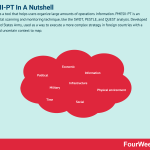
PMESII-PT is a tool that helps users organize large amounts of operations information. PMESII-PT is an environmental scanning and monitoring technique, like the SWOT, PESTLE, and QUEST analysis. Developed by the United States Army, used as a way to execute a more complex strategy in foreign countries with a complex and uncertain context to map.
Understanding PMESII-PTPMESII-PT was developed by the United States Army as means of executing strategy in foreign countries with high complexity and uncertainty. This enables soldiers to analyze and then describe the conditions of their operating environment according to a mix of variables.
Ultimately, soldiers who use PMESII-PT become adaptive, flexible, and versatile decision-makers who rapidly respond to change. Businesses can also use this tool to examine the variables of the environment they operate in.
The six operational variables of PMESII-PTAccording to PMESII-PT, there are eight mutually connected operational variables:
1 – Political (P)This describes the political power, structure, and hierarchy within the operational environment (OE). Power may be divided among government or state institutions who exert their influence over tax and trade policy and general political stability.
At the organizational level, power means the ability to make decisions. Who holds ultimate sway over the direction of the company? Are there any unwritten or unofficial leaders?
2 – Military (M)Military describes the capabilities of all relevant actors (enemy, friendly, or neutral) within the OE.
What are the strengths and weaknesses of rival businesses? Can the weaknesses be exploited?
Who are the allies or threats to organizational success? Are there neutral relationships a business needs to nurture?
3 – Economic (E)This encompasses the behavior of individuals or groups toward the production, distribution, or consumption of resources.
Do illegal economic activities exist within the OE? What is the nature of the banking system? What is the basis of the economy? In other words, it is based on technology, manufacturing, or agriculture?
On the micro-level, economic variables include the location of the business, mandated minimum wage, and local employment competition to name a few.
4 – Social (S)What is the ethnic, cultural, or religious composition of the operating environment? What are the associated beliefs, values, and customers of society members?
Cultural and religious background can impact organizational procedures and processes. Does the business model gel with the social norms in a community? For example, an abattoir business may be unable to operate in a predominantly Hindu society where cows are considered sacred.
5 – Information (I)The information variable describes the nature, scope, and effects of those who collect, process, disseminate, or act on information.
What is the role of the media? Is access to information free and unrestricted? How will the actions of the organization influence media reporting and subsequent public opinion?
6 – Infrastructure (I)Infrastructure describes the facilities or services that sustain the functioning of a community or society.
In business, infrastructure might describe research and development, technological capability, and IT operations. It also describes resources key to business operations, such as electricity, water, transportation, and a capable workforce.
7 – Physical environment (P)On the macro level, the physical environment describes the climate, weather, and geography of the operating environment.
But it also describes man-made structures. How is the business integrated with the community it serves? Is it located in an area receiving high foot traffic? Does it have a highly visible bricks-and-mortar presence or is it entirely online?
8 – Time (T)What is the timing or duration of activities or events within the OE? How is the timing or duration viewed by various actors?
For example, do business hours reflect the needs of the target audience? How can the business take advantage of holidays, major events, or sales periods such as Black Friday?
Key takeaways:PMESII-PT helps businesses assess large amounts of complex and inter-related operations information.PMESII-PT was developed by the United States Army to guide strategy during operations in foreign countries. However, businesses can also use the tool to evaluate their operating environment.PMESII-PT is underpinned by eight variables: political, economic, military, social, information, infrastructure, physical environment, and time.Read Next: SWOT Analysis, Personal SWOT Analysis, TOWS Matrix, PESTEL Analysis, Porter’s Five Forces, TOWS Matrix, SOAR Analysis.
Amazon SWOT AnalysisApple SWOT AnalysisCostco SWOT AnalysisCoca-Cola SWOT AnalysisDisney SWOT AnalysisFord SWOT AnalysisFacebook SWOT AnalysisGoogle SWOT AnalysisNestlé SWOT AnalysisNetflix SWOT Analysis Microsoft SWOT Analysis SWOT Analysis Of StarbucksTesla SWOT AnalysisUber SWOT AnalysisSamsung SWOT AnalysisMain Free Guides:
Business ModelsBusiness StrategyBusiness DevelopmentDigital Business ModelsDistribution ChannelsMarketing StrategyPlatform Business ModelsTech Business ModelWhat Is EntrepreneurshipThe post PMESII-PT In A Nutshell appeared first on FourWeekMBA.
3×3 Sales Matrix
The 3×3 Sales Matrix is a diagnostic and investigative tool used to shorten the B2B sales cycle.
Understanding the 3×3 Sales MatrixEffective sales processes are contingent on making tough decisions in two key areas:
Determining how to best enter an opportunity. Businesses who enter high can access key decision-makers, but it is difficult to initiate conversations and connect with these individuals. Entering lower gives greater access to constructive dialogue, but this often means the business is not connecting with people who have authority.Determining when the investigation/diagnosis of a business case is complete. Here, the business must create an impactful business case that can withstand potential inertia. But it must not become so complicated that it passes the point of diminishing returns.Indeed, the wrong decision in either of these areas has significant implications for the business. Poor decisions can kill the opportunity before it has a chance to flourish. They can also consign the opportunity to a state of purgatory where it slowly atrophies from inaction.
In the next section, we will take a look at how balanced decisions can be made in each of these areas.
Implementing 3×3 Sales Matrix principlesTo begin, the business should endeavor to establish three key points of entry. Importantly, there should be variation in the level and responsibility of each point.
The creators of the matrix argue that contact should be made with the following stakeholders:
The role or title that is tasked with managing the relevant problem.The role or title the above person reports to.A senior role or title.A peer role or title to the boss of the first person.A role below the person identified as managing the problem. This is useful in situations where a senior person is the initial point of entry.Role players, or those who do not directly manage problems but are nonetheless impacted by them.Determining whether the investigation has been adequate
It should be noted that determining the right time to end an investigation is highly situational.
Nevertheless, there are a few key questions to keep in mind:
Is the issue worthy of the time, energy, and money invested? Is the level of risk acceptable for both parties? Does the proposed solution to a problem satisfy budgetary constraints? How can the solution benefit a business directly and indirectly?How committed are interested parties to the status quo? Many deals fall through because certain individuals would rather live with issues rather than make the effort to address them.Implementing the 3×3 Sales MatrixThe 3×3 Sales Matrix is a simple but effective tool that can be used by salespeople and managers alike.
Information from each question in the previous section should demonstrate multiple impacts at multiple levels of the organization.
To incorporate this information into the matrix, the business should:
Connect and then engage with three contacts at three different levels (or areas) of the client organization.Identify three issues that each contact is facing that the business can impact.This creates a total of nine boxes which, if filled adequately, give the business greater insight into managing sales opportunities and efficient resource allocation. Most importantly, a well-thought-out matrix increases the odds of making the sale.
Key takeaways:The 3×3 Sales Matrix is an investigative and diagnostic tool to shorten the B2B life cycle, helping a business make balanced decisions.The 3×3 Sales Matrix advocates that a business contacts three roles or titles of varying responsibility. Then, it must determine whether the proposed solution is feasible or viable.The 3×3 Sales Matrix features nine squares that incorporate valuable information on the problems that individuals are experiencing in the client organization. Importantly, the business must be able to propose a high-impact solution.Read Next: SWOT Analysis, Personal SWOT Analysis, TOWS Matrix, PESTEL Analysis, Porter’s Five Forces, TOWS Matrix, SOAR Analysis.
Main Free Guides:
Business ModelsBusiness StrategyBusiness DevelopmentDigital Business ModelsDistribution ChannelsMarketing StrategyPlatform Business ModelsTech Business ModelWhat Is EntrepreneurshipThe post 3×3 Sales Matrix appeared first on FourWeekMBA.
Context Diagram In A Nutshell
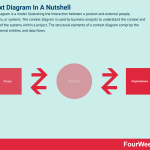
A context diagram is a model illustrating the interaction between a product and external people, organizations, or systems. The context diagram is used by business analysts to understand the context and boundaries of the systems within a project. The structural elements of a context diagram comprise the product, external entities, and data flows.
Understanding a context diagramThe context diagram identifies the flow of information between the system and external entities (actors) and helps the project team identify the interfaces that it needs to account for.
Businesses will find context diagrams to be useful when:
Work has begun on a new product that is expected to interact or impact existing systems.An existing process is being automated, involving the building of a new system or the implementation of a commercial off-the-shelf (COTS) system.An existing system needs to be replaced – which interfaces will be impacted by the upgrade?Revisions need to be made to a system such that interfaces need to be added or removed.The context diagram usually forms part of a requirements document and must be read and understood by all key project stakeholders. As a result, it should incorporate plain language wherever possible.
The structural elements of a context diagramTo illustrate key interactions, the diagram incorporates three symbols according to the elements they represent. These elements include:
The product (circle) – or any system, process, or business entity responsible for processing and sending information to each entity. Importantly, the product in question must be within the control of the initiative to change. Systems, processes, people, or organizations that cannot be changed by the initiative should be represented as external entities.External entities (rectangles) – defined as the people, organizations, and systems that provide data to (or consume data from) the product. In a hotel reservation system (product), external entities include hotel guests, financial institutions, and external reservation systems.Data flow (directional arrows) – how does the product interact with external entities via data transfer? This encompasses user interfaces, file transfers, reporting, and APIs among other things. Each data flow is represented by an arrow annotated with text detailing the type of data that flows between the product and each entity. The label itself should be a noun giving a very general description of the data flow. For example, data flow between a bank and a hotel reservation system may include labels such as “payment validation request” and “payment validation”.Benefits of context diagramsProject teams that are unfamiliar with context diagrams should know that they can realize several benefits:
Error identification. Context diagrams provide a means for noting omissions or errors in a business plan or project. This helps the business mitigate risks and reduce costs before project implementation.Scope definition. In some cases, the scope of a project may be hard to communicate to every stakeholder. The context diagram clearly illustrates the scope of a project in a way that is relatable and understandable.Customer clarification. The project team can use the diagram to provide clarity on the user group that it considers to be its customers. This gives the organization impetus and purpose and allows project sponsors to make targeted investment decisions.Key takeaways:A context diagram graphically represents the flow of information between a product and its people, systems, or organizations.A context diagram contains a product, process, system, or business entity at its center. The product is connected to external entities by directional arrows which describe the nature of data flow between the product and each entity.A context diagram must be created in such a way that all project stakeholders can understand the conceptual relationships between key elements. Primarily this is achieved by assigning very general, noun-based descriptions to the data flow.Read Next: SWOT Analysis, Personal SWOT Analysis, TOWS Matrix, PESTEL Analysis, Porter’s Five Forces, TOWS Matrix, SOAR Analysis.
Main Free Guides:
Business ModelsBusiness StrategyBusiness DevelopmentDigital Business ModelsDistribution ChannelsMarketing StrategyPlatform Business ModelsTech Business ModelWhat Is EntrepreneurshipThe post Context Diagram In A Nutshell appeared first on FourWeekMBA.
Use Case Modeling In A Nutshell
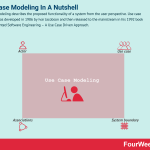
Use case modeling describes the proposed functionality of a system from the user perspective. Use case modeling was developed in 1986 by Ivar Jacobson and then released to the mainstream in his 1992 book Object-Oriented Software Engineering – A Use Case Driven Approach.
Understanding use case modelingUpon release, the book popularized use case modeling as a technique to capture functional requirements in software development.
Use case modeling can be applied in the following scenarios:
Capturing system requirements.Driving the implementation and generation of test cases.Specifying the context of a system.Validation of a systems architecture.Developed by analysts with domain experts.The core elements of a use case modelAs a minimum, the use case model contains the following basic elements that are graphically depicted to show the relationship between each element:
Actor – who is using the system? Actors encompass both human users and other computer systems. They use a use case to perform some piece of work that is of value to the business. The overall role and scope of each actor in the system are defined by the set of use cases they have access to.Use case – what do the actors want to achieve? A use case describes how the system should respond under various conditions to a request from an actor to deliver a specific goal. Think of a use case as representing a discrete unit of meaningful work, such as the fulfilment of a new order or the registering of a new account. A discrete use case may incorporate the functionality of another use case or extend a use case with its own behavior.Associations – or the relationship between actors and the particular use cases they interact with. System boundary – which defines the system of interest with respect to the world around it.The core elements of a use case descriptionUsing elements of the use case model, a use case description provides a detailed, step-by-step account of the interaction between the actor and the system. This sequence of steps is called a scenario.
Ultimately, the account should clearly show how the actor must initiate an action to derive value and achieve a goal.
To that end, it should contain the following:
Title – which must communicate the goal of the use case. In the case of a student wanting to sign up for a volleyball class, the title may be “Register Student for Volleyball Class”.Description – or a summary of what the use case does.Actors – again, these are the people or systems who interact with the use case.Preconditions – what needs to be in place before the use case can commence?Postconditions – what conditions must be met for the scenario to end, either successfully or unsuccessfully?Path – or the step-by-step interaction between the actor and the system, divided into three types. The primary path is the most commonly taken route to a successful conclusion. The alternate path is a less commonly used route to the same conclusion. The exception path leads to an unsuccessful conclusion and may incorporate an error message or further instruction.Date of creation and revision history – this chronology helps determine how old the use case is when undertaking document analysis.Priority and frequency of use – how important is the use case? How often is it executed? Both are useful in solution planning.Key takeaways:Use case modeling describes the proposed functionality of a system from the perspective of the user.At the very least, a use case model should contain four basic elements: actor, use case, associations, and system boundary.Use case modeling necessitates that a use case description is written. This is a series of steps that provides an account of the interaction between the actor and the system.Read Next: SWOT Analysis, Personal SWOT Analysis, TOWS Matrix, PESTEL Analysis, Porter’s Five Forces, TOWS Matrix, SOAR Analysis.
Main Free Guides:
Business ModelsBusiness StrategyBusiness DevelopmentDigital Business ModelsDistribution ChannelsMarketing StrategyPlatform Business ModelsTech Business ModelWhat Is EntrepreneurshipThe post Use Case Modeling In A Nutshell appeared first on FourWeekMBA.
Triple Constraint Theory In A Nutshell
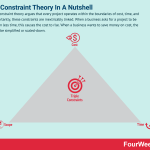
The triple constraint theory argues that every project operates within the boundaries of cost, time, and scope. Importantly, these constraints are inextricably linked. When a business asks for a project to be completed in less time, this causes the cost to rise. When a business wants to save money on cost, the scope must be simplified or scaled-down.
Understanding the triple constraint theoryThe triple constraint theory has been used in project management for over 50 years.
The theory argues that every project operates within the boundaries of three constraints:
Scope – defined as the range, breadth, reach, spectrum, or dimension of the work to be done. Put differently, what work is being done and how much work is there?Time – or the amount of time required to complete project tasks or the project itself.Cost – including resources related to labor, hardware, software, equipment, materials, and so on.The triple constraint theory is a useful discussion point during client conversations. Businesses use the theory to remind prospective clients that a project cannot be cheap, comprehensive, and fast at the same time. In competitive industries where time is of the essence, it can also be used to set realistic expectations regarding cost and scope.
Additions to the triple constraint theoryWhile the theory has been a mainstay of project management for several decades, critics suggest that the three constraint model is inaccurate and impractical.
In response, the Project Management Institute (PMI) added a further three constraints:
Quality – what are the characteristics of the deliverable? Is it functional? Does it satisfy the needs or expectations of the stakeholder? In the context of triple constraint theory, quality is a highly subjective term. A new piece of software could have less functionality than was formally agreed upon and still be a success. However, a car manufacturer that decides against its vehicles offering air conditioning will not be associated with quality by consumers in hot climates.Risk – a significant factor in project management. How does the business identify, analyze, and respond to risk? What level of risk is the project team willing to endure? Establishing a project risk tolerance level then becomes one of the six constraints.Benefit – represented by the value the project is expected to deliver to the organization and end-user. If a project will not deliver benefits, then it should not be started. If a project deliverable such as revenue falls below a predetermined limit, then the project should be stopped. Here, the constraint is the point at which the business no longer deems the project viable.Key takeaways:The triple constraint theory argues that every project is constrained by three inter-related factors: time, cost, and scope.The triple constraint theory is a useful way to keep client expectations in check during the consultation process.Some argue that the triple constraint theory is outdated and irrelevant for modern businesses. In response, three more constraints (quality, risk, and benefit) were added to the theory by the Project Management Institute.Read Next: SWOT Analysis, Personal SWOT Analysis, TOWS Matrix, PESTEL Analysis, Porter’s Five Forces, TOWS Matrix, SOAR Analysis.
Main Free Guides:
Business ModelsBusiness StrategyBusiness DevelopmentDigital Business ModelsDistribution ChannelsMarketing StrategyPlatform Business ModelsTech Business ModelWhat Is EntrepreneurshipThe post Triple Constraint Theory In A Nutshell appeared first on FourWeekMBA.
Value/effort Matrix In A Nutshell
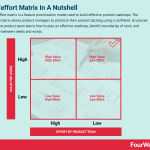
The value/effort matrix is a feature prioritization model used to build effective product roadmaps. The value/effort matrix allows product managers to prioritize their product backlog using a confident, structured approach. The product team learns how to plan an effective roadmap, identify boundaries of work, and differentiate between needs and wants.
Understanding the value/effort matrixPrioritization is a vital component of product management and the product development lifecycle.
However, many product managers tend to prioritize minor customer complaints or some shiny new idea they thought of yesterday. Many managers are also ill-equipped to make important decisions – whether through a lack of experience or access to appropriate tools or processes. As a result, the product backlog can quickly become a recess for hundreds of unnecessary features or bugs.
Ultimately, effective prioritization means striking a balance between delivering value and the resources available.
The next section will detail how this balance might be achieved.
Using the value/effort matrixThe value/effort matrix is a 2×2 matrix with:
Effort on the x-axis, defined as the resources needed to complete a task. That is, how difficult will the task be to complete?Value on the y-axis, defined as the business or product value a feature will bring. Value can be defined in several ways. How will the feature help gain new customers? How many customers will the feature impact? How does the feature help the business make money? Does the feature increase product virality?For both value and effort, the team should create a scoring system and rank each feature accordingly. A sample scoring system is provided below:
1 – minimal value/extra small effort.5 – low value/small effort.8 – medium value/medium effort.13 – high value/large effort.20 – super-high value/extra-large effort.The team can then plot each feature on the matrix according to its value and effort score, landing in one of four quadrants:
Time sinks (low value/high effort) – or tasks that should be left until last or abandoned altogether.Fill-ins (low value/low effort) – this describes features that can be completed during periods of low activity between other project tasks.Quick wins (high value/low effort) – these tasks should be prioritized to build momentum and boost team morale.Big projects (high value/high effort) – or valuable features that are complex and resource-intensive. These often long-term projects must be backed by detailed plans.Lastly, the value/effort matrix must be revisited periodically. Information derived from customer feedback, analytics, and A/B testing should be fed back into the matrix to reassess each feature.
Key takeaways:The value/effort matrix is a feature prioritization model used in product development.The value/effort matrix helps product managers make structured and confident feature prioritization decisions. This ensures the product backlog does not become overwhelmed with low-value initiatives.The value/effort matrix evaluates features on a matrix consisting of four quadrants: time sinks, fill-ins, quick wins, and big projects. The evaluation process should be repeated periodically as new insights come to hand.Read Next: SWOT Analysis, Personal SWOT Analysis, TOWS Matrix, PESTEL Analysis, Porter’s Five Forces, TOWS Matrix, SOAR Analysis.
Main Free Guides:
Business ModelsBusiness StrategyBusiness DevelopmentDigital Business ModelsDistribution ChannelsMarketing StrategyPlatform Business ModelsTech Business ModelWhat Is EntrepreneurshipThe post Value/effort Matrix In A Nutshell appeared first on FourWeekMBA.
Ulrich Model In A Nutshell
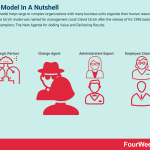
The Ulrich model helps large or complex organizations with many business units organize their human resource function. The Ulrich model was named for management coach David Ulrich after the release of his 1996 book Human Resource Champions: The Next Agenda for Adding Value and Delivering Results.
Understanding the Ulrich modelIn the book, Ulrich argues that the role of human resource professionals must be redefined to meet the competitive challenges modern businesses face. That is, organizations must stop viewing HR as an administration tool and instead see it as a strategic tool.
To some extent, the function of HR has changed organically. Once the foundation of every business, HR administrative activities are increasingly outsourced or automated. Furthermore, the traditional HR model of a single, large team of generalists and specialists is reducing in size.
Given this context, HR management is evolving from a bureaucratic function with a focus on operations to a strategic support function based on consultancy. That is, HR is becoming more of a trusted advisor and less of a policy officer.
Ultimately, many businesses are encouraging this shift by following the four basic principles of what many refer to as “Ulrichism”:
Define a clear, new role for HR.Determine how this role facilitates competitive advantage.Create a unified structure that consistently delivers value.Measure how the company has performed according to predefined metrics.The four roles of a HR professionalAccording to Ulrich, these are the four roles a HR professional must play in an organization:
Strategic partner (Strategic HR) – who develops and aligns strategies with business results and fosters systems thinking with a focus on customers.Change agent (Transformation & Change) – with a deep understanding of organizational culture, the change agent institutionalizes the capacity for change. Primarily this is enabled by training individuals and assisting line managers as they lead change initiatives.Administrative expert (HR Service Delivery) – tasked with creating HR processes that are both effective and efficient. They must also be tailored to the individual needs of the business without cost overruns.Employee champion (Employee Contribution) – these individuals create competent and committed employees and ultimately increase human capital contribution. Employee champions also recognize the power of digital design in increasing engagement among the emerging millennial-generation workforce.Strengths and weaknesses of the Ulrich modelStrengthsThe Ulrich model advocates that processes be simplified, standardized, re-engineered, and automated wherever possible. With less time spent on bureaucratic internal processes, human resources can direct more effort toward strategic goals.With a new model for HR administration, traditionally negative notions of HR practitioners are expelled. Company culture and employee morale increase when staff can see that HR has a vested interest in adding value to the business.WeaknessesImplementation time. The Ulrich model is an organization-wide strategy that will take time to realize maximum effectiveness. Implementation time is also increased because the business must adopt all four of the stipulated HR roles and create job descriptions for each.Confusion over the model. Some businesses argue that the original model is outdated or obsolete. However, Ulrich has made several updates to the model over the years, with the most recent being in 2012. Some businesses also believe that the Ulrich model proposes a blueprint for restructuring HR with defined job titles. However, this is not the case. Businesses must adapt each of the four roles according to their needs.Key takeaways:The Ulrich model represents a paradigm shift in human resource function. It is particularly suited to large or complex organizations with multiple business units.The Ulrich model defines four key roles that HR must play in an organization: strategic partner, change agent, administrative expert, and employee champion.The Ulrich model shifts the focus from resource-intensive bureaucracy to one of delivering value to the business. However, it does take time to implement and there is some confusion over whether the model is a blueprint or a methodology.Read Next: SWOT Analysis, Personal SWOT Analysis, TOWS Matrix, PESTEL Analysis, Porter’s Five Forces, TOWS Matrix, SOAR Analysis.
Main Free Guides:
Business ModelsBusiness StrategyBusiness DevelopmentDigital Business ModelsDistribution ChannelsMarketing StrategyPlatform Business ModelsTech Business ModelWhat Is EntrepreneurshipThe post Ulrich Model In A Nutshell appeared first on FourWeekMBA.
What is tactical management?
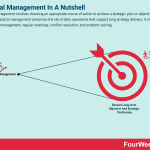
Tactical management involves choosing an appropriate course of action to achieve a strategic plan or objective. Therefore, tactical management comprises the set of daily operations that support long strategy delivery. It may involve risk management, regular meetings, conflict resolution, and problem-solving.
Understanding tactical managementMonash University defines tactical management as “the administrative process of selecting among appropriate ways and means of achieving a strategic plan or objective. The use of tactical management in a business environment allows a manager to choose the best tactics or methods for each situation that arises, rather than following a particular standard procedure.“
In understanding tactical management, it is helpful to differentiate it from strategic management. This is referenced in the above quote as “standard procedure”, which usually refers to creating a strategy that sets the direction for the organization as a whole. Strategic management also defines roles, responsibilities, and the commitment of resources.
Tactical management, on the other hand, encompasses the daily operations that support long strategy delivery. It may involve risk management, regular meetings, conflict resolution, and problem-solving.
Tactical management often necessitates that a quick decision is made using tactics that are best suited to the particular situation. Conversely, strategic management requires thought, discussion, and planning. Or, as we saw earlier, the following of standard procedure.
Examples of tactical management tasksFollowing is a look at two strategic goals and the tactical management tasks that may underpin them.
1 – Recruiting, developing, and then retaining a diverse and suitably experienced staff cohort:Establish a compensation benchmark based on industry salary data.Occupy a booth at a school or university job expo and liaise with a diverse range of student bodies.Regularly measure employee job satisfaction and engagement through surveying.Create an exit interview program to better understand the reasons for a high-performer seeking employment elsewhere.Provide training for managers to identify and allocate funds for employee upskilling or recertification.2 – The implementation of flexible work arrangements:Start by conducting a thorough review of the industry to determine the feasibility of flexible work arrangements.From the list of feasible options, survey employees on which they deem is the most interesting.For the option to be implemented, develop a policy and procedure framework.Review the implementation framework annually in light of changing or extenuating circumstances.Tactical management in investingTactical management is also prevalent in investing. Despite the differences between business strategy and investment strategy, tactical management is used in a similar way.
Using a tactical approach, investors intend to take advantage of daily market conditions using a range of acceptable percentages in each broad asset class.
On a red day, the intent is to act more defensively and reduce equity exposure. On a green day, however, the tactics pivot toward utilizing the higher end of each asset class.
In the same way tactical management supports business strategy, similar day-to-day management of the stock market helps supports the broader, long-term strategy of the investor.
Key takeaways:Tactical management involves selecting the appropriate course of action to achieve strategic goals or objectives.Tactical management encompasses day-to-day operations such as conflict resolution, problem-solving, staff training, and the definition of roles, responsibilities, and procedures.Tactical management is also useful for stock market investors whose primary strategy is supported by managing daily market volatility.Read Next: SWOT Analysis, Personal SWOT Analysis, TOWS Matrix, PESTEL Analysis, Porter’s Five Forces, TOWS Matrix, SOAR Analysis.
Main Free Guides:
Business ModelsBusiness StrategyBusiness DevelopmentDigital Business ModelsDistribution ChannelsMarketing StrategyPlatform Business ModelsTech Business ModelWhat Is EntrepreneurshipThe post What is tactical management? appeared first on FourWeekMBA.
RFQ vs. RFP: What are an RFQ and RFP?
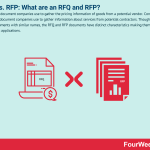
An RFQ is a document companies use to gather the pricing information of goods from a potential vendor. Conversely, an RFP is a document companies use to gather information about services from potential contractors. Though they are similar documents with similar names, the RFQ and RFP documents have distinct characteristics making them suitable for different applications.
Understanding the RFQ and RFP documentBusiness to business (B2B) operations are often difficult as key personnel struggle with the clientele attainment process. With hundreds of potential companies to do business with, how can an organization receive the best price for its goods and services?
When a business needs to procure goods or services from a prospective vendor, Request for Proposal (RFP) and Request for Quote (RFQ) documents are used. However, understanding which document is most suitable is vital.
Though they are similar documents with similar names, the RFQ and RFP documents have distinct characteristics making them suitable for different applications.
Selecting one document over another is an important skill in successfully negotiating corporate sales.
The difference between RFQ and RFP documentsWith the above in mind, here are the key differences between each.
Request for Quote (RFQ)A Request for Quote document is used to gather information about goods or services from the vendor. Before the procurement process, the RFQ stipulates the type and quantity of the product the business wishes to purchase.
Then, potential vendors send a quote in reply and the business chooses a vendor based on price. This makes them ideally suited to large-scale purchases where minimizing costs is a priority.
Request for Proposal (RFP)A Request for Proposal document is used by companies to gather information about services from a potential contractor or supplier. Note that RFP documents are more complex than RFQ documents because they are asking for more than a simple price estimate.
Thus, the information contained in an RFP might detail:
The nature of the project the buyer needs to complete, including project goals.The number of pages or illustrations the proposal should contain.Laws the project is potentially subject to.Qualifications that a vendor or contractor must possess.Using the stipulations outlined above, the contractor submits a proposal estimating the costs of labor, management, and other relevant fees to give a total cost. Where relevant, the contractor will also detail a list of needs that must be met to complete the project successfully.
Then, the company assesses each proposal and selects a contractor based on price and their ability to detail the project scope.
So, what are the main differences?
The first and most obvious difference is the level of detail each document offers. An RFQ is well-suited to an itemized list of materials with known specifications. However, an RFP is more suited to large-scale projects where construction, maintenance, or legal advice is required.
It’s also important to note that RFP documents are part of a formal procurement process. The request leaves no room for interpretation or last-minute changes and edits can only be made with an official addendum. The RFQ request, on the other hand, has a more casual structure that can be adapted to suit. This is particularly true when a buyer accepts a quote it is happy with before the assigned due date.
Key takeaways:A Request for Proposal (RFP) document is used by companies wishing to gather information about large-scale services from potential contractors. A Request for Quote (RFQ) document is used when a company wants a simple, itemized quote for goods or services.Although similar in name and appearance, successful corporate sales managers understand that each document is effective for different reasons and in different scenarios.There are many differences between the RFP and RFQ documents. Perhaps the most pertinent is that an RFP forms part of a formal procurement process, whereas an RFQ is less formal and more flexible.Read Next: SWOT Analysis, Personal SWOT Analysis, TOWS Matrix, PESTEL Analysis, Porter’s Five Forces, TOWS Matrix, SOAR Analysis.
Main Free Guides:
Business ModelsBusiness StrategyBusiness DevelopmentDigital Business ModelsDistribution ChannelsMarketing StrategyPlatform Business ModelsTech Business ModelWhat Is EntrepreneurshipThe post RFQ vs. RFP: What are an RFQ and RFP? appeared first on FourWeekMBA.



